#native american cuisine
Text

Three Sisters Soup (Vegan)
#vegan#lunch#dinner#native american cuisine#soups#three sisters soup#beans#corn#squash#summer squash#tomatoes#onion#garlic#sage#chili#coriander#bell peppers#apple cider vinegar#maple syrup#sea salt#pumpkin seeds
30 notes
·
View notes
Photo
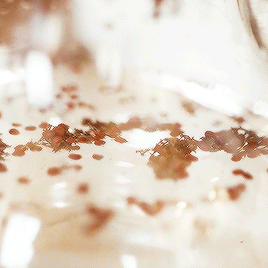



sumac lemonade.
#foodedit#food#food gifs#foodcore#recipes#mine#gifs#sumac lemonade#sumac#drinks#native american cuisine#native american recipes#indigenous american cuisine#indigenous american recipes
65 notes
·
View notes
Text
reclaiming Native American food : NPR
9 notes
·
View notes
Text
some american self proclaimed chef saying america doesn't have any cultural food is embarrassing like you were led astray so badly 😓 hope you get well soon
#then she said we cant all claim native american food as our own as if anyone was trying to lmao#pointing out native americans also have their own cuisine that shows the richness of american cultural food alongside our fusion foods is??
62 notes
·
View notes
Text
“The question led Barton to scholars like David Morgan and Kristen Gremillion, and obscure discoveries in places like Kentucky’s Red River Gorge, a 29,000-acre canyon system in the Daniel Boone National Forest.
Before the Gorge finds, archaeologists “assumed that the peoples of this region just sat around passively, waiting for others to send them the gift of agriculture,” says Morgan, director of the National Park Service’s Southeast Archaeological Center. “But that simply wasn’t the case.”
Plant materials recovered by archaeologists in the Gorge in the 1980s and ‘90s led to a historical revision “that fundamentally alters how we think about indigenous peoples of the [precontact eastern U.S.],” says Morgan. A trove of ancient seeds debunked then-dominant theories “depicting early inhabitants as backwater nomads that didn’t acquire agriculture—and thus the markers of complex society—until after A.D. 1, when maize arrived from Mesoamerica.”
Gremillion, a paleoethnobotanist, chairs the Ohio State University department of anthropology and is the author of Ancestral Appetites: Foods in Prehistory. She started working in the Gorge around 1989, using techniques such as direct radiocarbon dating and high-magnification microscopy to study ancient caches of seeds, food stores, cooking refuse, and human feces. She found specimens buried under massive stone outcroppings and in caves—all in remarkable condition.
“We found things like 3,000-year-old sunflower heads and baskets full of seeds,” says Gremillion, who compares the digs to opening storage vaults. The finds were unprecedented, and old vanguard archaeologists were dismissive. “They said the materials couldn’t possibly be so old.”
Gremillion’s research proved them wrong; the region’s indigenous peoples had been farming for more than 5,000 years. The work helped establish the Eastern Woodlands as an independent center of prehistoric plant domestication and agricultural development—alongside areas like southeast Asia, Mexico, and the Fertile Crescent.”
#appalachia#cherokee#cuisine#ancestral appetite#Kristen gremillion#atlas obscura#nico albert#taelor barton#native american#cooking#recipes#pre contact
200 notes
·
View notes
Text
"There may indeed be excellent food in America, but it isn't American cuisine, it's French" bro it's almost like French culture has been deeply influential to U.S. culture
#like I don't understand why#food that is CLEARLY English in origin but made with ingredients native to North America gets classified as American cuisine#but food that is French in origin but made with ingredients native to North America is still considered French#why is that?#both of those cultures had a huge impact on early American life and culture#it's weird that they get treated so differently by food academics#anyways ignore this#I picked up that American Cuisine book again#and it is still making me mad#and I am posting here because I can not fistfight the author
9 notes
·
View notes
Text
Why do all of the posts on this site about mexican cuisine, culture, and language in the (formerly Mexico) US always skip right over New Mexico.
#all you people talk about are tejanos and California#but NM is so unique in cuisine and culture and uh literally has Mexico in the name!#and 4th largest native american population in the US making up 10% of the population
1 note
·
View note
Note
I had read a fic of yours where Batson was Australian, I don't know if you have other requests like this but if you accept, make one with Batson being Brazilian and he likes football, carnival and who likes to listen and dance to music by the great diva Anitta
Okay, that's cool. I never really knew a lot about Brazil, but I love learning more about it. Bruce is really mister worldwide lol.
Summary: (Y/N) is Brazilian.
Warnings: none

According to Jason, Bruce has become mister Worldwide. Why, I might hear you asking? He, as a playboy, sleeps with a lot of women. One of those women was a Brazilian model and the two had a son together. Bruce took a DNA first because he didn't want to take any type of chances.
It wouldn't be a first time that a woman tried to claim that a kid was his, but wasn't. Turns out, DNA came back telling him that (Y/N) was his son. Thankfully, the woman was very understanding and Bruce sent her money every month and he would visit when he could.
Unfortunately, (Y/N)'s mom passed away when he was a teen and he came to live in the USA with his father and half brothers. It was a little bit weird at first, a new city, a father who is a vigilante, his brothers too, a butler who is their handler so to speak...
Either way, it was weird, but he was happy to be here with his family. That was something that he thought that Americans were lacking sometimes. That feeling of tight nit love and family. His family, including grandmas, grandpas, aunts and much more lived within a walking distance from him.
Okay, that may sound like Americans don't share that same sentiment about family, but (Y/N) didn't really see it. It may that in Brazil that is just amplified by 10 or it could be something else of course. However, his family is tight knit and very loving.
(Y/N) didn't think that he would have that here in America, but hey, he can't really complain can he.
However, there is a single thing he will fight until the day he dies. His fellow Brazilian men and women, his brothers and sisters would agree. Soccer is not football. Football is football, you play with your feet. That's why is so popular.
And that's why Europeans and Latinos went nuts for it. Honestly, (Y/N) watches every game with Brazil's national team, even if Bruce had to pay more for the program. He has the money. He can't let his son suffer, can he?
Also, American Football should be named American Soccer, because the ball is never on the ground. (Y/N) will die by that statement and he will fight everyone he needs to fight with to prove it.
Until his last breath and last drop of blood.
One thing he loves more than anything, alongside the football of course, is the famous Rio de Janeiro carnival. He made Bruce and the rest of the family go every single year with him. Thankfully, he still has his Brazilian passport with him.
And the family has a translator for when they go, because not a lot of people speak English, only in bigger cities and popular tourist sites. It's fun to see (Y/N) speak his native language with so much passion and everyone has decided to learn it to talk to (Y/N).
(Y/N) was proud and nothing but supportive, even though at times they were butchering the language, but it's always the thought that matters. And Portuguese is an easier language to pick up. (Y/N) even had some rewards for them.
Every time they could hold a some what correct conversation when it comes to grammar and vocabulary, they would get a dish from the Brazilian cuisine. It's the famous Feijoada and it's just (Y/N)'s favorite. Everyone loved when (Y/N) made it and it was with his grandma's recipe.
That's what motivated them to learn, because even Damian swore by that dish and he loved it the most. Bruce and the rest loved it, it was different then the rest of the American cuisine. Of course, (Y/N) introduced them to another dishes, but everyone loved the Feijoada.
(Y/N) knew it.
One thing he loves is listening to Anitta. He loves her music and they would often find him dancing while he was cleaning, dusting, vacuuming and other times. It made him happy and Bruce found (Y/N) humming the melody and the lyrics every day.
Everyone soon knew the lyrics to the songs and the melody. And besides, they are all learning Portuguese and it was fun to learn it that way. Dick found her songs great and listened to it during his workouts and Dick loved it.
And one thing that Bruce was proud of was the fact that (Y/N) didn't decided to assimilate. He still has his values and he wasn't afraid to say that he is Brazilian. If he has an interview he is often found correcting people and he is not afraid to say it.
Due to the fact that he is not afraid to say he is from Brazil, people of Brazil have claimed him and whenever he comes, they just shower him with love. He is extremely popular and Bruce knows he shouldn't worry about it, but still.
Bruce worries about his children all of the time, especially when they are in another country, especially on vacation. (Y/N) often told him not to worry and did Bruce listen?
No.
One thing more thing that made Bruce love Brazil more than anything in this world is the fact that they take their hygiene more than some Americans do. (Y/N) said to everyone that during the summer he would take 3 showers per day sometimes.
Damian found that interesting. Brazil is a humid and hot country, considering that it's a tropical country and the heat is often unforgiving.
(Y/N) said that the shower made him slow down and think about relaxing. He often clears his head and feels less stress afterwards. He has explained the shower routine, but still, the family they don't really understand it, but hey, as long (Y/N) is happy.
And one thing that Brazilians love doing that Bruce found nice was the way that they are affectionate. Kisses, hugs and touching. Of course, with consent. (Y/N) understood that not really liked it, but his family loved it.
Damian would often get picked randomly and hugged from behind. Damian would often grumble about it, but he loved it. Bruce loved the hugs and the rest loved the hugs too.
Bruce was just happy that one of them was normal emotionally. (Y/N) was trained in martial arts to protect himself, like everyone, but decided to not be a vigilante. He just couldn't be and Bruce respected it.
(Y/N) was their safety net and nobody would have it any other way.
#dc x male reader#dc comics#x male reader#batfamily#bruce wayne x male reader#jason todd x male reader#batman x male reader#red hood x male reader#tim drake x male reader#red robin x male reader#damian wayne x male reader#robin x male reader#nightwing x male reader#dick grayson x male reader
259 notes
·
View notes
Text
Reading list for Afro-Herbalism:
A Healing Grove: African Tree Remedies and Rituals for the Body and Spirit by Stephanie Rose Bird
Affrilachia: Poems by Frank X Walker
African American Medicine in Washington, D.C.: Healing the Capital During the Civil War Era by Heather Butts
African American Midwifery in the South: Dialogues of Birth, Race, and Memory by Gertrude Jacinta Fraser
African American Slave Medicine: Herbal and Non-Herbal Treatments by Herbert Covey
African Ethnobotany in the Americas edited by Robert Voeks and John Rashford
Africanisms in the Gullah Dialect by Lorenzo Dow Turner
Africans and Native Americans: The Language of Race and the Evolution of Red-Black Peoples by Jack Forbes
African Medicine: A Complete Guide to Yoruba Healing Science and African Herbal Remedies by Dr. Tariq M. Sawandi, PhD
Afro-Vegan: Farm-Fresh, African, Caribbean, and Southern Flavors Remixed by Bryant Terry
Barracoon: The Story of the Last “Black Cargo” by Zora Neale Hurston
Big Mama’s Back in the Kitchen by Charlene Johnson
Big Mama’s Old Black Pot by Ethel Dixon
Black Belief: Folk Beliefs of Blacks in America and West Africa by Henry H. Mitchell
Black Diamonds, Vol. 1 No. 1 and Vol. 1 Nos. 2–3 edited by Edward J. Cabbell
Black Faces, White Spaces: Reimagining the Relationship of African Americans to the Great Outdoors by Carolyn Finney
Black Food Geographies: Race, Self-Reliance, and Food Access in Washington, D.C. by Ashanté M. Reese
Black Indian Slave Narratives edited by Patrick Minges
Black Magic: Religion and the African American Conjuring Tradition by Yvonne P. Chireau
Black Nature: Four Centuries of African American Nature Poetry edited by Camille T. Dungy
Blacks in Appalachia edited by William Turner and Edward J. Cabbell
Caribbean Vegan: Meat-Free, Egg-Free, Dairy-Free Authentic Island Cuisine for Every Occasion by Taymer Mason
Dreams of Africa in Alabama: The Slave Ship Clotilda and the Story of the Last Africans Brought to America by Sylviane Diouf
Faith, Health, and Healing in African American Life by Emilie Townes and Stephanie Y. Mitchem
Farming While Black: Soul Fire Farm’s Practical Guide to Liberation on the Land by Leah Penniman
Folk Wisdom and Mother Wit: John Lee – An African American Herbal Healer by John Lee and Arvilla Payne-Jackson
Four Seasons of Mojo: An Herbal Guide to Natural Living by Stephanie Rose Bird
Freedom Farmers: Agricultural Resistance and the Black Freedom Movement by Monica White
Fruits of the Harvest: Recipes to Celebrate Kwanzaa and Other Holidays by Eric Copage
George Washington Carver by Tonya Bolden
George Washington Carver: In His Own Words edited by Gary Kremer
God, Dr. Buzzard, and the Bolito Man: A Saltwater Geechee Talks About Life on Sapelo Island, Georgia by Cornelia Bailey
Gone Home: Race and Roots through Appalachia by Karida Brown
Ethno-Botany of the Black Americans by William Ed Grime
Gullah Cuisine: By Land and by Sea by Charlotte Jenkins and William Baldwin
Gullah Culture in America by Emory Shaw Campbell and Wilbur Cross
Gullah/Geechee: Africa’s Seeds in the Winds of the Diaspora-St. Helena’s Serenity by Queen Quet Marquetta Goodwine
High on the Hog: A Culinary Journey from Africa to America by Jessica Harris and Maya Angelou
Homecoming: The Story of African-American Farmers by Charlene Gilbert
Hoodoo Medicine: Gullah Herbal Remedies by Faith Mitchell
Jambalaya: The Natural Woman’s Book of Personal Charms and Practical Rituals by Luisah Teish
Just Medicine: A Cure for Racial Inequality in American Health Care by Dayna Bowen Matthew
Leaves of Green: A Handbook of Herbal Remedies by Maude E. Scott
Like a Weaving: References and Resources on Black Appalachians by Edward J. Cabbell
Listen to Me Good: The Story of an Alabama Midwife by Margaret Charles Smith and Linda Janet Holmes
Making Gullah: A History of Sapelo Islanders, Race, and the American Imagination by Melissa Cooper
Mandy’s Favorite Louisiana Recipes by Natalie V. Scott
Medical Apartheid: The Dark History of Medical Experimentation on Black Americans from Colonial Times to the Present by Harriet Washington
Mojo Workin’: The Old African American Hoodoo System by Katrina Hazzard-Donald
Motherwit: An Alabama Midwife’s Story by Onnie Lee Logan as told to Katherine Clark
My Bag Was Always Packed: The Life and Times of a Virginia Midwife by Claudine Curry Smith and Mildred Hopkins Baker Roberson
My Face Is Black Is True: Callie House and the Struggle for Ex-Slave Reparations by Mary Frances Berry
My Grandmother's Hands: Racialized Trauma and the Pathway to Mending Our Hearts and Bodies by Resmaa Menakem
On Her Own Ground: The Life and Times of Madam C.J. Walker by A'Lelia Bundles
Papa Jim’s Herbal Magic Workbook by Papa Jim
Places for the Spirit: Traditional African American Gardens by Vaughn Sills (Photographer), Hilton Als (Foreword), Lowry Pei (Introduction)
Post Traumatic Slave Syndrome by Dr. Joy DeGruy
Rooted in the Earth: Reclaiming the African American Environmental Heritage by Diane Glave
Rufus Estes’ Good Things to Eat: The First Cookbook by an African-American Chef by Rufus Estes
Secret Doctors: Ethnomedicine of African Americans by Wonda Fontenot
Sex, Sickness, and Slavery: Illness in the Antebellum South by Marli Weiner with Mayzie Hough
Slavery’s Exiles: The Story of the American Maroons by Sylviane Diouf
Soul Food: The Surprising Story of an American Cuisine, One Plate at a Time by Adrian Miller
Spirituality and the Black Helping Tradition in Social Work by Elmer P. Martin Jr. and Joanne Mitchell Martin
Sticks, Stones, Roots & Bones: Hoodoo, Mojo & Conjuring with Herbs by Stephanie Rose Bird
The African-American Heritage Cookbook: Traditional Recipes and Fond Remembrances from Alabama’s Renowned Tuskegee Institute by Carolyn Quick Tillery
The Black Family Reunion Cookbook (Recipes and Food Memories from the National Council of Negro Women) edited by Libby Clark
The Conjure Woman and Other Conjure Tales by Charles Chesnutt
The Home Place: Memoirs of a Colored Man’s Love Affair with Nature by J. Drew Lanham
The Jemima Code: Two Centuries of African American Cookbooks by Toni Tipton-Martin
The President’s Kitchen Cabinet: The Story of the African Americans Who Have Fed Our First Families, from the Washingtons to the Obamas by Adrian Miller
The Taste of Country Cooking: The 30th Anniversary Edition of a Great Classic Southern Cookbook by Edna Lewis
The Tuskegee Syphilis Study: An Insiders’ Account of the Shocking Medical Experiment Conducted by Government Doctors Against African American Men by Fred D. Gray
Trace: Memory, History, Race, and the American Landscape by Lauret E. Savoy
Vegan Soul Kitchen: Fresh, Healthy, and Creative African-American Cuisine by Bryant Terry
Vibration Cooking: Or, The Travel Notes of a Geechee Girl by Vertamae Smart-Grosvenor
Voodoo and Hoodoo: The Craft as Revealed by Traditional Practitioners by Jim Haskins
When Roots Die: Endangered Traditions on the Sea Islands by Patricia Jones-Jackson
Working Conjure: A Guide to Hoodoo Folk Magic by Hoodoo Sen Moise
Working the Roots: Over 400 Years of Traditional African American Healing by Michelle Lee
Wurkn Dem Rootz: Ancestral Hoodoo by Medicine Man
Zora Neale Hurston: Folklore, Memoirs, and Other Writings: Mules and Men, Tell My Horse, Dust Tracks on a Road, Selected Articles by Zora Neale Hurston
The Ways of Herbalism in the African World with Olatokunboh Obasi MSc, RH (webinar via The American Herbalists Guild)
1K notes
·
View notes
Text

Three Sisters Soup (Vegan)
#vegan#lunch#dinner#soups#earth day#native american cuisine#canadian cuisine#three sisters soup#beans#zucchini#corn#potato#tomatoes#garlic#onion#jalapeño#cumin#bay leaf#parsley#olive oil#black pepper#sea salt
82 notes
·
View notes
Text
Little hc of mine but I love to imagine a Native American / indigenous yuu/mc who sometimes speaks in their native language and the octavinelle trio absolutely adoring them or looking at them with admiration and love for them.
Idk it would just be sweet to think.
Teaching Azul or Jade their native language and both of them trying to speak it to mc
Or them telling Floyd their culture stories and Floyd listening to them, since he loves stories (as long as he finds them interesting)
This example is more specific, but mc trying to explain clans to the three of them (I’m Navajo, but I’m still trying to understand how clans work myself 😭), jade would probably understand after explaining, but Azul and Floyd still struggling to understand.

Mc making frybread for them and native cuisines (Azul would probably try to sell it at the restaurant for a special time), I think Floyd’s favorite would be navajo tacos, and Jade’s would probably be the three sisters stew (bout to be a fourth sister since you know he probably add mushrooms to that shit-). Azul’s would probably enjoy three sisters stew too.
Idk, as someone who really didn’t grow up with the representation, I just enjoy making these little hcs for my native ocs sharing their culture with my favorite fictional characters are a huge comfort, especially me myself who is starting to reconnect with my roots, just a nice way to make me feel good about myself.
Are there any native/indigenous or just different people from different cultures who also play Twisted wonderland? If so what are your personal hcs for your indigenous mc sharing their culture with the NRC boys? (I would love to hear em)
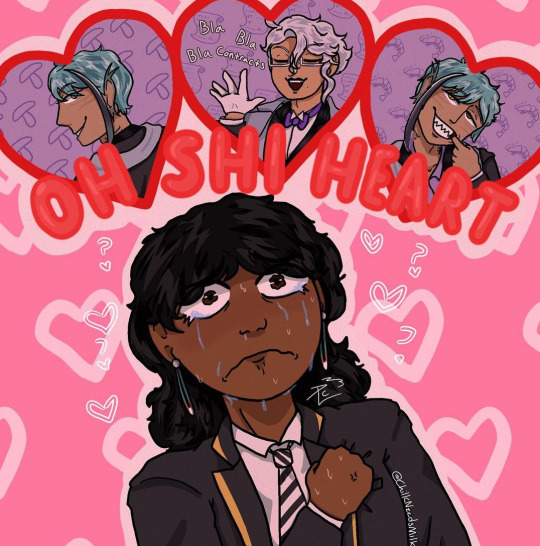
#twisted wonderland#azul ashengrotto#twisted wonderland mc#jade leech#floyd leech#twst azul#twst mc#azul x mc#azul x yuu#twst jade x mc#twst headcanons#twst floyd x mc#azul ashengrotto x reader#jade leech x reader#floyd leech x reader#twisted wonderland x reader#twisted wonderland x yuu#twst x reader#twst x yuu#native#native oc
110 notes
·
View notes
Text
I think the Edgeworths ate like any other family. I think Gregory packed Miles simple lunches with off-brand food because brand name is a little too pricy. I think at dinner time, Gregory brought home bags of something that was cheap and quick and hot because his son deserves hot meals and he just does not have the energy to cook.
And then Miles start eating food he can't pronounce--all from different countries he barely knows. It's well-prepared, but he never sees anyone cook. His lunches are neatly made with proper food groups. Vegetables and cheeses that hurt his tummy and cold bread and desserts that are too sweet.
He misses hot meals and fried spam and salty noodles. The beeping rice maker. Tea before bed instead of the glass of milk von Karma's staff makes him drink even though he keeps saying it makes him feel sick.
But eventually. He forgets it. He gets older. He finds preference in French-inspired cuisine and dishes native to Germany. He gets caught sneaking into the kitchen to get to German chocolate cake. There are some happy memories of almost befriending other boys and getting kebabs after school with them.
When he settles back into America, he doesn't pick up any of the food he grew up with even though it's all around him. LA grocery stores are full of it. Street vendors. Restaurants. Many of them are Japanese-American, but he's become a stranger to his own diaspora, and it's the strangest feeling.
And then he's 22 and tired and it's going on midnight. A case has taken him out of the city for a full day. He sits in the passenger seat of Gumshoe's car, aching and silent.
Gumshoe pulls over at a late-night restaurant, a little hole in the wall run by a family. Miles drags his feet. The lights are too bright. The menu items are faded.
And, ashamed, he doesn't remember the items listed as he once did.
Gumshoe tells him to sit, find them a table. They're the only two in there. Miles sits in a booth with a table that looks less than clean. His stomach hurts he's so hungry. He feels sick. He knows that that must be why Gumshoe insisted on stopping.
Gumshoe joins him and then a young girl puts two bowls of udon in front of them.
Miles had forgotten the thick noodles. The hot broth. The fishiness. He tries eating as he's been taught is polite, but muscle memory takes over. He puts the end of the noodles in his mouth and slurps.
He feels warm at the bottom of the bowl.
They share dorayaki, and Miles feels almost too full, but he lets bean paste sit on his tongue, mushes it against the roof of his mouth like he used to.
Gumshoe pays, and Miles gets back in the car. He less tired and more drowsy. There's still 30 minutes left of the drive, and Miles doses for a few of those.
He stumbles inside his house and collapses into bed, into warm sheets. And it feels like, with sweetness still on his lips and warmth still in belly, that his father is just across the hall.
168 notes
·
View notes
Text

November is National Native American Heritage month in the USA! Did you know that many of the UK’s favourite kitchen garden plants were originally domesticated by indigenous peoples in the Americas? The Native Americans’ domesticated plants now feed most of the world and have become an integral part of cuisines in Europe, Africa, and Asia.
1. Potato: Potato (Solanum tuberosum) was domesticated by indigenous Americans in the Andes at least 10,000 years ago. Genetic studies indicate hybridization of different wild potato varieties in the species Solanum brevicaule in Southern Peru produced the original domesticated potato. Today, indigenous people in Peru have over 4000 varieties of potato, each with their culinary and cultural significance. The Chuño potato can be preserved for up to 15 years, making it an important food source during lean times in the days of the Inca Empire.
2. Corn: Indigenous Americans domesticated corn (Zea mays) from the wild grass Teosinte (Zea mays parviglumis) of southwestern Mexico approximately 9,000 years ago. The wild Teosinte is a miniature corn, with ears containing only 5-12 hard seeds. From the initial domestication in Mexico, corn spread north and south to become the iconic food plant of indigenous America. Native American corn differs from the familiar sweetcorn because it was selectively bred to be dried and preserved rather than eaten fresh. Native American corn varieties can be a kaleidoscope of beautiful colours and are either flint corn (dried for preservation and then soaked for food purposes), flour corn (processed into masa harina flour), or popcorn.
3. Beans: Our familiar kitchen garden beans all come from indigenous American agriculture. The fresh green beans and most of the dried beans belong to the same species, the Common Bean (Phaseolus vulgaris) which was domesticated via hybridization of several wild species in Mesoamerican around 4,000 years ago. The Lima Bean (Phaseolus lunatus) was domesticated in South America around 4,000 years ago and spread north of the Rio Grande by the 1300’s.
#katia plant scientist#plants#gardening#agriculture#crops#potatoes#corn#beans#native american#native american heritage month#indigenous food#history#native american culture#native american food#domestication#botany#plant based
48 notes
·
View notes
Text
Red dead gang + flowers
Arthur Morgan - Dudleya cymosa; Canyon liveforever, native to California cliff faces and craggy areas, thrives in the sun and blooms vibrant red and orange cymes. Pointed rosettes of succulent leaves form the base which sends out a delicate bloom in early summer. This flower is also the one found in the terrarium jar on Arthur's bedside table.
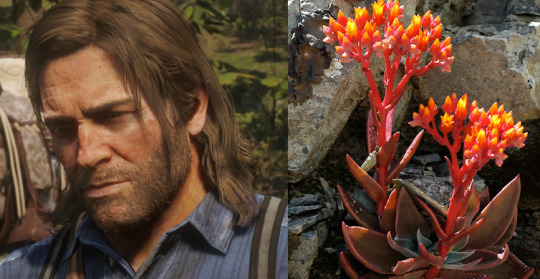
Tilly Jackson - Helianthus annuus; Common sunflower, a showy plant native to grasslands in the US, its undomesticated form is a branching annual plant with many flower heads. Its domesticated form is an important food crop grown both for its seeds and seed oil. It's common in sunny gardens, where its unmistakable bright blooms attract pollinators. Commonly symbolizes longevity and adoration.

Sean Maguire - Tripolium pannonicum; Sea aster, native to Ireland, a very hardy plant that requires very little to thrive. Showy purple blooms usually a bit ruffled, but all the brighter in their seaside environments.
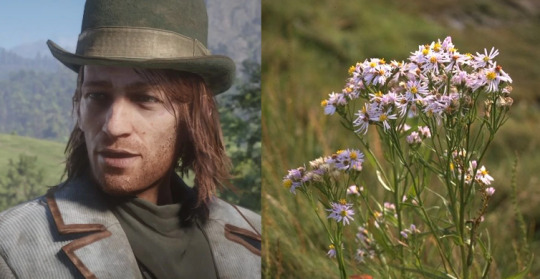
Charles Smith - Quercus alba; White oak, a staple crop for thousands of years, white oaks of the Quercus genus are amongst the most important habitat species for wildlife in North America. These trees provide food, shelter, fuel, and fertilizer for countless native flora and fauna, and oaks are among the few trees that thrive in both open fields and sheltered forests. Their diminuitive flowers (catkins) are wind pollinated and mature into thousands of acorns per tree every 2-10 years. Traditionally associated with bounty, wisdom, and protection. (Not a flower in the traditional sense, but catkins do count and white oak really REALLY suited Charles so I'm putting this in)
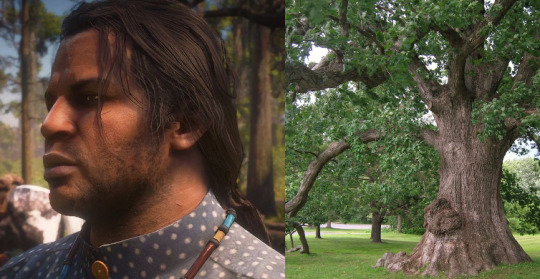
Dutch Van Der Linde - Pueraria montana; Kudzu vine, a hardy, subtropical plant introduced to the US with bright sweet pea flower spikes in spring. Rapidly spreads to completely cover native flora, shading out and crushing plants and depleting habitat for mutualistic wildlife. This vine is a noxious invasive in the southern US.
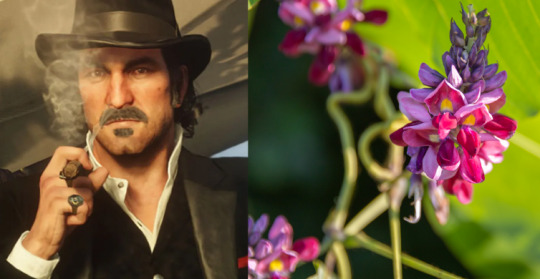
Hosea Matthews - Triticum aestivum; Wheat, grown as a staple crop around the world, wheat has many uses and is considered the backbone of western cuisine. Often grown in wide monocrop fields, mature wheat's golden color makes for a striking image. Commonly symbolizes bounty and resurrection. (Yes, grass (Poaceae) is a flowering plant family!)

Mary-Beth Gaskill - Viola riviniana; Common dog violet, native to europe, its nodding purple blooms can be found along roads and creeks in lightly shaded areas. Flowers in this genus traditionally symbolize modesty and humility.

Abigail Roberts/Marston - Rudbeckia hirta; Black-eyed Susan, a popular midwest native wildflower common in gardens for its sunny florets and contrasting center. Its association with gardening is a long established one, and traditionally symbolizes encouragement, adaptability, and determination.
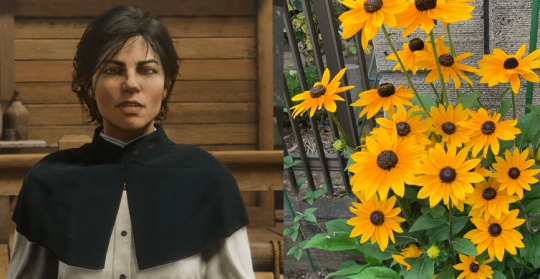
Molly O'Shea - Passiflora alata; Winged-stem passionflower, a species native to the south American tropics and known for its visually distinctive red petals and exotic striped filaments. A delicate looking nodding flower with an edible fruit, commonly cultivated for its medicinal benefits and its beauty.
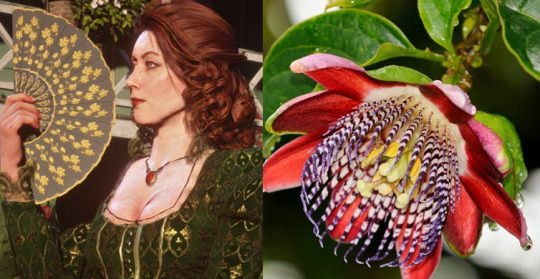
This post got very long! I will make a part two to save you the effort of scrolling <3
#rdr2#Red Dead Redemption 2#Botany#Long post#Arthur Morgan#Tilly Jackson#Sean Macguire#Dutch van der Linde#Hosea Matthews#Mary Beth Gaskill#Abigail Roberts#Molly O'Shea#*combines my two special interests*
322 notes
·
View notes
Text
EAST INDIGENOUS NORTH AMERICAN RESOURCES
The Anthropological Masterlist is HERE.
The Midwestern United States is a North American region that constitutes the northern central part of the United States.
HURON ─ “The Wyandot, or Huron, people are an Indigenous North American people. They are native to the north of Lake Ontario.”
─ Huron Information
─ Huron History
─ Huron Language
LAKOTA ─ “The Lakota people are an Indigenous North American people. They are native to North and South Dakota.”
─ Lakota Language
─ Lakota Language Reclamation Project
─ Lakota Dictionary
SENECA ─ “The Seneca people are an Indigenous North American people. They are native to the south of Lake Ontario.”
─ Seneca Information
─ Seneca Culture
─ Seneca Language
The Northeast United States is a North American region that constitutes the northeastern part of the United States.
BLACKFOOT ─ “The Blackfoot people are an Indigenous North American military confederation that share the Blackfoot language. They are native to northeastern America.”
─ Blackfoot Culture
─ Blackfoot Language
LENAPE ─ “The Lenape, or Leni Lenape, people are an Indigenous North American people. They are native to the Northeastern Woodlands.”
─ William Penn on the Lenape
─ Lenape Language
─ Lenape Dictionary
NARRAGANSETT ─ “The Narragansett people are an Indigenous North American people. They are native to Rhode Island.”
─ Narragansett Records
─ Narragansett Language
─ Narragansett Language
WAMPANOAG ─ “The Wampanoag, or Wôpanâak, people are an Indigenous North American people. They are native to southeastern Massachusetts.”
─ Chappaquiddick Wampanoag Information
─ Wampanoag Culture
─ Wampanoag Language Reclamation Project
The Southern United States is a North American region that constitutes the southern part of the United States.
CADDO ─ “The Caddo people are an Indigenous North American people. They are native to the Southeastern Woodlands of the United States.”
─ Caddo History
─ Caddo Language
─ Caddo Alphabet
CHEROKEE ─ “The Cherokee are an Indigenous North American people. They are native to the Southeastern Woodlands of the United States.”
─ Cherokee Information
─ Cherokee Culture and History
─ Cherokee Dictionary
CHICKASAW ─ “The Chickasaw people are an Indigenous North American people. They are native to the southeastern United States.”
─ Chickasaw History
─ Chickasaw Language
─ Chickasaw Language and Word Stress
CHOCTAW ─ “The Choctaw, or Chahta, people are an Indigenous North American people. They are native to Alabama and Mississippi.”
─ Choctaw Information
─ Choctaw Culture
─ Choctaw Mythology
CREEK ─ “The Creek, or Muskogee, people are an Indigenous North American people. They are native to the Southeastern Woodlands in the United States.”
─ Creek Information
─ Creek Language
*GULLAH ─ “The Gullah people are an African American people. They live in the Lowcountry Region of the United States.”
─ Gullah Culture
─ Gullah Cuisine
KIOWA APACHE ─ “The Plains Apache are an Indigenous North American people. They are native to Oklahoma and Texas.”
─ Apache Information
─ Apache Culture
─ Apache Creation Myth
PAWNEE ─ “The Pawnee people are an Indigenous North American people. They are native to Oklahoma.”
─ Pawnee Information
─ Tirawa of Pawnee Legend
─ Pawnee Dictionary
POWHATAN ─ “The Powhatan, or Powatan, people are an Indigenous North American people. They are native to eastern Virginia.”
─ Important Powhatan People
─ Powhatan History
─ Powhatan Language
* - The Gullah are not indigenous North American people. They are an African diasporic people.
#resources#midwestern united states#northeastern united states#southern united states#huron#lakota#seneca#blackfoot#lenape#narragansett#wampanoag#caddo#cherokee#chickasaw#choctaw#creek#gullah#kiowa apache#pawnee#powhatan
382 notes
·
View notes
Note
Sin, can I ask about the other German food crimes?
so basically, one rule of thumb where i live is that if you want truly authentic foreign cuisine, you should probably look for a restaurant owned by natives and their families, because germans might (and in a lot of cases WILL) fuck it up by germanizing it in some way. at least that's the experience i've made here in the east of the country.
(you've probably seen videos of US americans fucking up foreign dishes while some native of that country is reacting to it with pure horror. same shit, different country.)
i remember there was a german-owned mexican restaurant in my city that i wanted to try, and i got myself a burrito. it was so germanized that it was the blandest food i'd had all week. lacking spices and everything that makes a good burrito. i wish i had taken a picture that i could show you now.
i am not saying that germans can't learn or master foreign cuisine, but that takes some training / trial and error, which a lot of people don't really bother with.
to give you an example of why it might be a mistake to trust germans with foreign cuisine:
(pictures of strange german food under the cut, you've been warned)
this is a mettigel. a minced meat hedgehog.
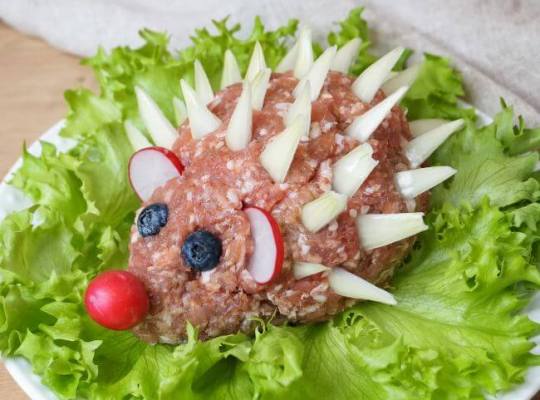
i am not kidding you, this is just a pile of meat with onions and other decorative veggies to make it look like a hedgehog.
some germans consider this a must-have at parties.
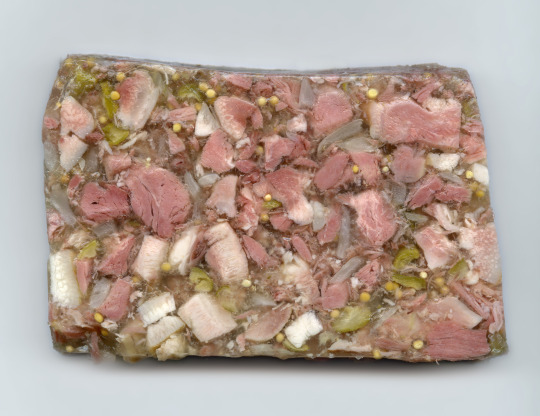
this is sülze. from what we know it's been around before germany as we know it today was even a thing. but germany took and ran with it. sülze is nothing but meat and veggies in gelatin. i don't know many people who like it, but i've been told it's very popular with boomers.
i have more examples, but i guess you see why it might be a bad idea to trust germans with food they don't know shit about.
(i would have shown you pictures of foreign food fucked up by germans but i couldn't find good ones. apparently we don't take enough pictures of that stuff that make it beyond astronomically bad google reviews.)
15 notes
·
View notes